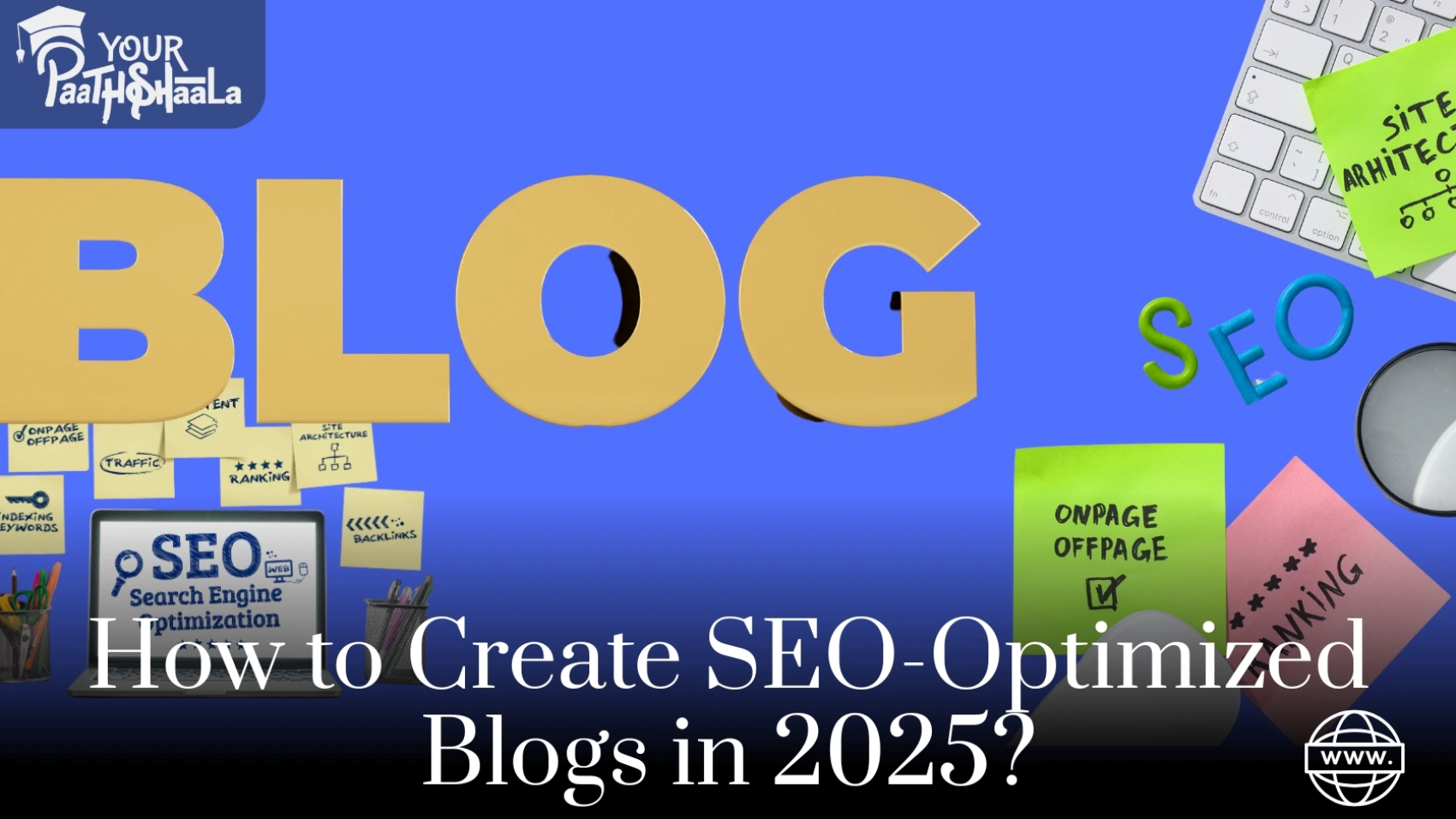Picture a Bengaluru startup publishing a blog on “Best Budget Smartphones in India,” skyrocketing to Google’s first page and attracting thousands of readers from Delhi to Kochi. In 2025, with 750 million smartphone users driving India’s $188 billion e-commerce market, writing SEO-optimized blogs is a powerful way to reach Indian searchers. For businesses, where 90% of internet traffic is mobile and 40% of searches use regional languages like Hindi and Tamil, SEO blogging boosts visibility, trust, and sales.
Fortunately, creating blogs that rank high on Google and resonate with Indian audiences is achievable, even for beginners. By blending smart keyword strategies, mobile-first design, and cultural relevance, you can craft content that shines. This guide walks you through how to write SEO-optimized blogs for Indian searchers in 2025, with practical steps, India-specific tips, real-world examples, and future trends. Whether you’re a Mumbai entrepreneur or a Chennai content creator, let’s make your blog a hit. Ready to start? Let’s dive in!
What Is SEO-Optimized Blogging?
SEO-optimized blogging involves writing content designed to rank high on search engines like Google while engaging readers. It combines strategic keywords, user-focused structure, and technical optimization to attract organic traffic. In India, where 60% of searches are mobile and voice search is rising, SEO blogs target specific queries like “best Diwali gifts 2025” or “Hindi learning apps.”
For example, a Jaipur retailer’s blog on “Traditional Rajasthani Handicrafts” ranked for local searches, driving 10,000 monthly visitors. SEO blogging, therefore, is about creating valuable content that Google and Indian searchers love.
Why SEO Blogging Matters for Indian Businesses
In 2025, SEO-optimized blogs are essential for Indian businesses. Here’s why:
- Organic Traffic Surge: Blogs with targeted keywords drive 55% more visitors, per Hostinger.
- Brand Credibility: Informative posts build trust, boosting engagement by 30%, per WebEngage.
- Mobile-First Reach: Optimized blogs for 90% mobile traffic rank higher, per Google.
- E-Commerce Growth: Blogs with UPI-linked CTAs tap into a $188 billion market.
- Cost-Effective Marketing: Blogs cost 62% less than ads, generating three times more leads, per BloggersPassion.
For instance, a Hyderabad tech firm’s blog on “AI Tools for Indian Startups” ranked on Google’s first page, doubling leads. SEO blogging, thus, fuels growth in India’s digital landscape.
Step-by-Step Guide to Writing SEO-Optimized Blogs
Follow these beginner-friendly steps to craft SEO-optimized blogs for Indian searchers in 2025. Each step is tailored to India’s mobile-first, diverse market.
Step 1: Research Keywords for Indian Searchers
First, find keywords that Indian audiences search for. Focus on terms relevant to your niche and location.
- Use Keyword Tools: Semrush or Google Keyword Planner (free) identify high-volume, low-competition keywords (e.g., “best laptops India 2025,” KD 15–49).
- Target Long-Tail Keywords: Phrases like “affordable sarees in Mumbai” have less competition and higher intent.
- Incorporate Local Terms: Include Hindi or Tamil keywords, like “Diwali gifts online,” for regional searches.
- Analyze Trends: Check Google Trends for seasonal queries, like “Rakhi gifts 2025.”
For example, a Delhi fashion brand targeted “budget kurtas for women” and ranked in Google’s top 10, gaining 8,000 visitors monthly. Keyword research ensures your blog matches searcher intent.
Tool: Semrush’s free Keyword Magic Tool for India-specific keywords.
Step 2: Understand Search Intent
Next, align your content with why Indian users search. Search intent falls into four types:
- Informational: “How to make filter coffee” (tutorials, guides).
- Navigational: “Flipkart Diwali sale” (brand-specific searches).
- Commercial: “best smartphones under ₹20,000” (product comparisons).
- Transactional: “buy kurtas online Mumbai” (purchase-focused).
For instance, a Chennai blog on “Tamil Nadu Travel Itineraries” matched informational intent, ranking in Google’s “People Also Ask” section. Understanding intent ensures your blog solves user problems.
Tip: Analyze top-ranking pages on Google to see what formats (lists, guides) work.
Step 3: Create a Mobile-Friendly Structure
Then, structure your blog for India’s 90% mobile traffic. A clear, scannable layout improves UX and SEO.
- Use Headings: H1 for titles, H2/H3 for sections, per ReuAds.
- Keep Paragraphs Short: 2–3 sentences for easy mobile reading.
- Add Visuals: Use Canva infographics or images with alt text (e.g., “Diwali gift ideas 2025”).
- Optimize Load Speed: Compress images to WebP for sub-1.5-second load times, per Google.
For example, a Kolkata bakery’s blog on “Bengali Sweets for Durga Puja” used short paragraphs and visuals, boosting dwell time by 25%. Mobile-friendly blogs rank higher and engage better.
Tool: Canva for free visuals; Pingdom for speed tests.
Step 4: Write Engaging, Localized Content
Moreover, craft content that resonates with Indian audiences. Focus on cultural relevance and value:
- Localize Content: Use Hindi, Tamil, or Bengali phrases, like “Holi ke liye best rangoli designs.”
- Address Pain Points: Solve issues, like a Pune blog on “Affordable Work-from-Home Setup.”
- Include CTAs: Add UPI-linked “Shop Now” buttons for e-commerce, per IndiaCSR.
- Tell Stories: Share relatable anecdotes, like a Jaipur retailer’s story of “From Village Crafts to Global Sales.”
For instance, a Kochi startup’s blog on “Sustainable Seafood Packaging” in Malayalam gained 15,000 views, driving ₹40,000 in sales. Localized, engaging content sparks shares and conversions.
Tool: Grammarly for error-free writing; Yoast SEO for optimization.
Step 5: Optimize for SEO and AEO
Next, enhance discoverability with SEO and Answer Engine Optimization (AEO). These techniques ensure your blog ranks high:
- SEO Basics: Use the focus keyword (e.g., “SEO-optimized blogs India 2025”) in the title, meta description, and first 100 words, per BloggersPassion.
- AEO for Voice Search: Include FAQs (e.g., “What are the best Diwali gifts?”) and bold key phrases for Google’s snippets, vital for 40% of Indian voice searchers, per BloggingQnA.
- Internal Links: Link to related posts, like “Top 10 Indian Startups” to boost dwell time by 20%.
- Meta Tags: Write 160-character meta descriptions, like “Learn how to write SEO-optimized blogs for Indian searchers in 2025 with these easy tips.”
For example, a Hyderabad blog on “AI Tools for Small Businesses” used FAQs, ranking in Google’s snippets and gaining 10,000 visitors. Optimization drives traffic.
Tool: Google Search Console for ranking insights.
Step 6: Promote Your Blog
Then, amplify your blog’s reach across India’s 672 million social media users. Promotion spreads your content fast:
- Social Media: Share on Instagram, YouTube, and X with hashtags like #IndiaSEO, per Sprout Social.
- WhatsApp Groups: Post links in regional communities, as a Mumbai brand did, earning 5,000 clicks.
- Email Newsletters: Send blog snippets to subscribers, boosting traffic by 15%, per Hostinger.
- Guest Posting: Write for Indian blogs like Trak.in to build backlinks, per Nestify.
For instance, a Pune startup shared a “Monsoon Fashion Guide” on X and Instagram, hitting 1 million views. Multi-platform promotion maximizes exposure.
Tool: Hootsuite’s free plan for scheduling posts.
Step 7: Analyze and Refine
Finally, track performance and improve your blog. Analytics reveal what resonates with Indian searchers:
- Monitor Metrics: Use Google Analytics to track traffic, bounce rates, and conversions.
- Test Formats: Experiment with listicles vs. guides, as a Delhi blog found listicles 2x more engaging.
- Update Content: Refresh posts with 2025 trends, like “Best Gadgets for Work-from-Home,” per ReuAds.
- Engage Readers: Respond to comments to boost dwell time by 10%.
For example, a Chennai travel blog analyzed 12,000 monthly views, tweaking keywords to gain 5,000 more. Iteration keeps your blog relevant.
Tool: Google Analytics for free traffic insights.
Challenges and Solutions
Writing SEO blogs in India has hurdles, but these solutions help:
- High Competition: Big brands dominate searches. Solution: Target long-tail keywords like “best Hindi books 2025,” per ReuAds.
- Time Constraints: Content creation is slow. Solution: Use AI tools like Typeflo for drafts, per F6S.
- Mobile Optimization: 60% of searches are mobile. Solution: Use responsive WordPress themes, per Hostinger.
- Cultural Relevance: Generic content fails. Solution: Localize with regional languages, per IndiaCSR.
For instance, Hindi blogs gain 20% more engagement, per BloggingQnA. Strategic planning overcomes these challenges.
Future Trends for SEO Blogging in 2025
Looking ahead, SEO blogging trends will shape Indian content:
- AI-Driven Content: Tools like Typeflo optimize drafts, per F6S.
- Voice Search Optimization: AEO targets 40% of Indian voice searches, per BloggingQnA.
- Hyper-Local Content: Blogs in Hindi or Tamil for Tier-II cities, per IndiaCSR.
- Video Integration: Embedding YouTube Shorts boosts engagement by 25%, per Nestify.
- Green Content: Eco-focused blogs resonate with Gen Z, per Forbes.
Consequently, by 2027, 70% of Indian blogs will use AI tools, per Forbes. Staying ahead ensures your blog ranks high.
Getting Started with SEO Blogging
Ready to write SEO-optimized blogs for Indian searchers? Here’s a quick recap:
- Research Keywords: Find low-competition, India-specific terms.
- Understand Intent: Match informational or transactional queries.
- Create Mobile-Friendly Structure: Use short paragraphs and visuals.
- Write Localized Content: Include regional languages and stories.
- Optimize for SEO/AEO: Add keywords, FAQs, and meta tags.
- Promote Widely: Share on Instagram, X, and WhatsApp.
- Analyze and Refine: Track metrics and update content.
For example, a Kochi startup’s blog on “Kerala Travel Tips 2025” hit 15,000 views with Hindi FAQs and Instagram promotion, earning ₹50,000 in bookings. Start small, rank big!
Tip: Use Hostinger’s ₹134/month hosting and WordPress for easy setup.
Conclusion
In 2025, writing SEO-optimized blogs for Indian searchers is a powerful way to reach 750 million smartphone users and tap into a $188 billion e-commerce market. By targeting long-tail keywords, localizing content, and optimizing for mobile and voice search, businesses can drive 55% more traffic and 30% higher engagement. Challenges like competition and time are manageable with AI tools and niche strategies. With AI, hyper-local content, and video integration shaping the future, now’s the time to act. Write your SEO blog today and make your business shine. What’s your blog idea for 2025? Share below and let’s make it rank! At Bestdigitalmarketingcourseinraipur you will learn a lot about digtital marketing and related topics.








